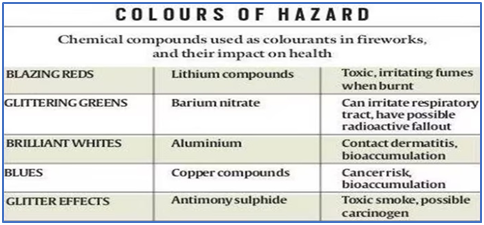SC says cracker order applies to country, not just NCR
09-11-2023
08:33 AM
1 min read

What’s in today’s article?
- Why in news?
- SC orders on firecrackers
- Firecrackers
- What is a firecracker made of?
- What are Green crackers?

Why in news?
- The Supreme Court clarified that its order banning the use of barium and other banned chemicals in firecrackers applies to the entire country, and not just the National Capital Region.
- The apex court was hearing an application that sought directions to the Rajasthan government to comply with the top court’s orders.
SC orders on firecrackers
- In October 2018, the apex court had banned the production and sale of all crackers except ‘green crackers’ and those with reduced emissions (improved crackers).
- It also:
- banned the manufacture and sale of ‘joined crackers’ (long rows of crackers joined together),
- prohibited the use of barium salts in fireworks and
- said their noise levels should be within permissible limits.
- In 2020, the National Green Tribunal had banned the sale and use of all kinds of firecrackers in NCR.
- It said that green crackers would be permitted only in cities and towns where air quality was moderate or poor.
- In September 2023, the SC junked a plea by the firecracker manufacturers’ association:
- to allow the use of joined crackers and
- to add barium with improved additives in green crackers.
What is a firecracker made of?
- Ingredients
- Firecrackers typically consist of four primary ingredients — oxidiser, fuel, colouring agents, and binder.
- An oxidiser is required for the cracker to catch fire;
- the fuel sustains the fire;
- colouring agents give it the colours and sparkles;
- the binder holds this mixture in place till the cracker has spent itself.
- Colouring agents
- Chemicals like barium are colouring agents.
- These were banned because of their harmful impact on human health, such as irritation in the respiratory tract, skin allergies, breathing difficulties, and even cancer.
- The white colour in a cracker is emitted through aluminium, magnesium and titanium, while the orange colour is carbon or iron.
- Similarly, yellow agents are sodium compounds while blue and red are copper compounds and strontium carbonates.
- The green agent is barium mono chloride salts or barium nitrate or barium chlorate.
- Firecrackers typically consist of four primary ingredients — oxidiser, fuel, colouring agents, and binder.
Green crackers
- About
- Green crackers are so named because they do not contain harmful chemicals that would cause air pollution.
- Components in firecrackers are replaced with others that are less dangerous and less harmful to the atmosphere.
- These crackers emit less-harmful chemicals, and also release water vapour, which acts as dust suppressant.
- Research done by
- The idea of producing green crackers was researched by a network of CSIR labs, including Central Electro Chemical Research Institute (CECRI), Indian Institute of Chemical Technology, National Botanical Research Institute and National Chemical Laboratory.
- Categories
- The three broad categories of such crackers are SWAS, SAFAL and STAR, developed by CSIR.
- SWAS stands for “safe water releaser”, and has a small water pocket that is released in the form of vapour when the cracker is burst. This suppresses dust.
- STAR, or safe thermite cracker, does not comprise potassium nitrate and sulphur, and emits reduced particulate matter at reduced sound intensity.
- SAFAL is safe minimal aluminium, which has minimum usage of aluminium, and used magnesium instead. This too emits less noise than traditional crackers.
Q1) What is National Green Tribunal (NGT)?
The National Green Tribunal (NGT) is a statutory body in India that was established on October 18, 2010 under the National Green Tribunal Act, 2010. The NGT is dedicated to the effective and expeditious disposal of cases relating to the subject of forest, environment, biodiversity, air and water. The Tribunal has a mandate to dispose of applications and petitions within a period of six months.
Q2) What is CSIR?
CSIR stands for Council of Scientific and Industrial Research. It is India's largest research and development (R&D) organization. The Government of India established CSIR as an autonomous body in September 1942. Its headquarters are in New Delhi.


